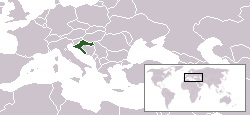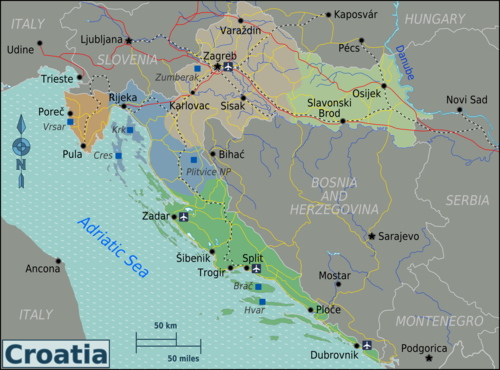| Localization | |
 | |
| Flag | |
 | |
| Basic information | |
| capital | Zagreb |
| Government | parliamentary republic |
| Currency | kuna (HRK) |
| Area | 56,542 km² |
| Population | 4,494,749 (est. July 2006) |
| Language | Croatian 96%, another 4% |
| Religion | Roman Catholics 87.8% |
| Electricity | 230V/50Hz |
| phone code | 385 |
| Internet TLD | .hr |
| Time zone | UTC 1 |
THE Croatia (Croatian: Hrvatska) is a country in the Balkans, in the south of Europe, on the shores of the Adriatic Sea and east of the Italy. borders with Slovenia to the northwest, Hungary at North, Bosnia Herzegovina to the east, Serbia northeast and Montenegro to the southeast.
Regions

Croatia is divided into 4 Regions, of which 2 belong to the North and 2 to the Coast. In turn, the regions are subdivided into 21 counties (sing., županija; pl. županije), including the country's capital, Zagreb
- To the north are:
- Those on the coast are:
Cities
- Zagreb, the capital
- Dubrovnik, a beautiful medieval town on the Adriatic Sea.
- split, the city of Diocletian's Palace.
- Varazdin, capital of the North County, shows us the vestiges of an occupation from the Neolithic to the Roman period.
- Osijek, capital of Slavonia and Baranja, industrial and university center.
- Karlovac, industrial city that stands at the crossroads to the rest of Europe.
- Rijeka, geographically strategic, has become Croatia's main seaport.
- porec, Roman city, has with ex-libris its Euphrasian Basilica as a World Heritage Site.
- jump, the real Roman city
- Zadar, sea port, emerged with the Illyrians, but the current layout is Roman.
- Sibenik, after independence, Sibenik has in its Cathedral of St. James a World Heritage Site.
- trogir, its historic core is a World Heritage Site.
Other destinations
- Plitvice National Park
- Brijuni National Park
- Kopacki Natural Park
- Trakoscan- North County Region
- Vukovar- Region of Slavonia and Baranja
- Ilok- Region of Slavonia and Baranja
- Dakovo- Slavonia and Baranja region
- Slavonski Brod- Slavonia and Baranja region
- Samobor- Region of Central Croatia
- Opatija- Istria and Kvarner Region
- labin- Istria and Kvarner Region
Understand
- Croatia, due to its geographical position, is a country with great ethnic, historical and architectural diversity and a varied topography.
Climate
Northern Croatia has a temperate continental climate whereas the central and highland regions have a mountainous climate. The entire Adriatic coast has a pleasant Mediterranean climate. Spring and autumn are mild along the coast, while winter is cold and snowy in the central and northern regions. The average terrestrial temperature in January ranges from -10 to 5°C, August 19th to 39°C. The average temperature on the coast is higher: January 06-11°C, August 21st to 39°C.
To arrive
Tourists holding passports Portuguese and Brazilian do not need a visa to stay up to 90 days in Croatia.
By airplane
Of boat
By car
By train
Circular
- Since Croatia is a small country, it makes distances between cities short. I strongly advise traveling by bus, as this service is very well organised.
- For those who like to extend their purse strings a little, rent a car, or if you go in a group. It is, without a doubt, a good way to get to know this fantastic country a little better.
Speak
- In Croatia, Croatian is spoken, a Slavic language that uses the Latin alphabet, very similar to Serbian, which uses the Cyrillic alphabet. There it is easy to understand, as they mostly speak English, followed by Italian, Russian, German and French. Also, for the Portuguese, it is easy to learn some basic words in Croatian. Out of curiosity, the natural language of Dalmatia, Dalmatian, now extinct, belonged to the group of Latin languages.
Buy
With the
drink and go out
Learn
Work
Safety
Health
respect
Stay in touch
| This article is outlined and need more content. It already follows a suitable model but does not contain enough information. Plunge forward and help it grow ! |

